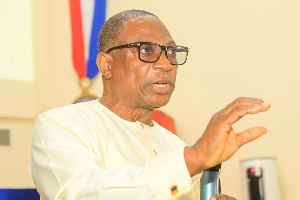By Samuel Hinneh
Born into a farming family where Lydia Sasu, a farmer and the executive director of Development Action Association (DAA) witnessed her mother struggle to make enough money to feed the entire family, she is excited to learn that the world isn’t as hungry as it used to be.
She is of the view that as the world’s population continues to grow, the pessimists worried it would be different, they insisted that we’d run out of food.
According to her, they claimed that more people would mean more hunger—more mouths to feed, more empty bellies, more malnourishment, more famine, and more starvation.
And yet the opposite is true, Lydia Sasu emphasised.
The statistics tell the story: In 1990, the global population of hungry people was about 1 billion. Today, this figure has dropped to less than 800 million, according to a new report from the Food and Agricultural Organization of the United Nations.
Sasu says this decline is more significant when we remember that the planet has about 2 billion more people compared to twenty-five years ago. We’ve gone from 5.3 billion to 7.3 billion people, she added.
"In other words, only 13 percent of the world’s population is hungry right now, down from 23 percent in 1990,” she said.
What a remarkable improvement.
"I’m fortunate to live in Ghana. We are not a rich country, but we enjoy food security. Just about everyone gets enough to eat. As a farmer who grows cassava, yams, and fruit on 30 acres, I help supply food for my family as well as for people in cities,” Sasu noted.
"I’ve seen amazing progress with my own eyes: Back in 1990, many people in Ghana went hungry. There are still pockets of hunger in some parts of the regions in Ghana, but today, hunger is almost non-existent. We make food and share food,” the executive director stated.
The UNFAO report says the number of malnourished people in my country is “not statistically significant.”
"Many farmers are able to plant better seeds. We use better techniques. We’ve also started to trade: Today, for example, we’re importing rice that some families can afford to support food security.
"We’re also blessed with political stability. This is one of the clear findings of the UNFAO study: Peace is good for food security. Conflict is devastating,” she stated.
The result is that millions of Ghanaians enjoy better access to food, Sasu emphasised.
"Despite this, we face lots of challenges. Urbanization devours our agricultural land. Climate change has made the seasonality of fishing and farming less predictable. Small-scale farmers don’t have easy access to the best seeds and fertilizer. Our rural women are an under-used resource.
"Our neighbours suffer worse problems. In the Ivory Coast, more than 13 percent of the population is malnourished. In Burkina Faso, it’s 21 percent. In Liberia, it’s 33 percent,” she says.
Although Ghana is a success story, Sub-Saharan Africa has not seen the agricultural benefits that the rest of the world now enjoys.
"My fellow Africans still must take advantage of the Green Revolution, with its improvements in seeds and fertilizer. We also must embrace the Gene Revolution, which has harnessed the power of biotechnology to produce bumper crops for those farmers who would like to use this technology wherever it’s introduced. Too many African countries have turned their backs on this option.
"Yet I’m not going to dwell on the bad news. Every time we open a newspaper or turn on a television news program, we learn of war, disease, and crime.
"We also learn of hunger—but not as much as we might. Since 1990, 72 countries have reduced their levels of hunger by at least half. Nine more are nearly there. South America has almost wiped out malnourishment. Asia and the Caribbean also have seen impressive declines, this is wonderful news. It is what I want for all of Africa,” Sasu said.
“We can indeed eliminate the scourge of hunger in our lifetime,” said Jose Graziano da Silva, head of the UNFAO.
"I don’t know if that’s really possible. As long as there is war, there will be hunger—and has there ever been a time without war? Yet it is a worthy goal and we’re closer to it now than when I was a young child. With access to improved seeds, fertilizers, soil and other modern tools of agriculture, higher food production is possible, even as the global population approaches 9 billion people by the middle of this century,” says Lydia Sasu, who is a member of Truth About Trade and Technology Global Farmer Network.
"This is especially true in Africa. If we’re going to continue to improve over the next twenty-five years, it’s going to be on my continent. We must choose success. We must choose technology. We must choose optimism,” she said.
Opinions of Wednesday, 19 August 2015
Columnist: Hinneh, Samuel














